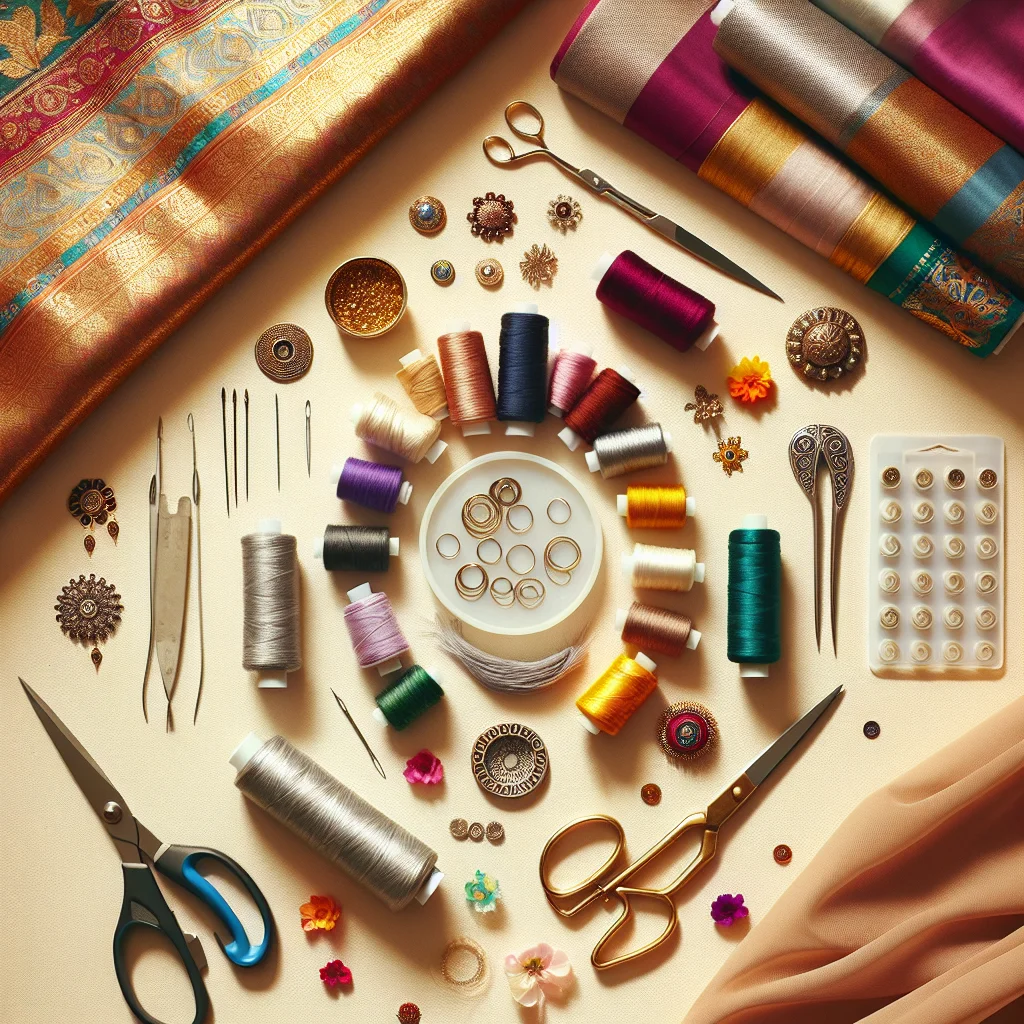Saree Kuchu Making Materials are the foundation of creating Baby Kuchu, one of the oldest and most elegant traditional tassel designs in South Indian saree finishing. Known for its thick and short tassels, Baby Kuchu adds grace to sarees, dupattas, and even lehengas.
This complete guide will show you the materials required, step-by-step process, styling ideas, and expert tips so you can make Baby Kuchu at home with professional finishing.
What is Baby Kuchu in Sarees?
Baby Kuchu is a traditional tassel design tied along saree borders. It is simple yet elegant, and its popularity has grown from silk sarees to cotton, linen, dupattas, stoles, kurtis, and lehengas.
Why Baby Kuchu is loved:
- Thick and neat tassels give a grand look.
- Simple enough for beginners.
- Works with multiple fabrics.
- Customizable in colors and lengths.
Tip: Match thread type with saree fabric. Use cotton thread for cotton sarees and silk thread for silk sarees to retain shine.
Saree Kuchu Making Materials (Complete List)
Here’s what you need to get started:
- Silk Thread – Best for silk sarees (Kanjeevaram).
- Cotton Thread – Perfect for cotton & linen sarees.
- Big Eye Needle – Helps pass tassels through saree edge.
- Zari (Gold/Silver) – Choose zari with thread inside, not wire.
- Hemming Needle – For secure tying.
- Trimmer/Scissors – To trim tassels neatly.
- Fabric Glue – For stronger knots.
- Cardboard or Notebook – To wrap equal thread lengths.
- Hair Straightener – To iron tassels for neat finishing.
Pro Tip: Use at least 100 strands for a rich Baby Kuchu.
Step-by-Step Guide: How to Make Baby Kuchu
Step 1 – Prepare the Threads
- Wrap silk/cotton thread around a cardboard piece 100 times.
- Cut carefully so all strands are of equal length.
Step 2 – Straighten the Strands
- Use a hair straightener on low heat.
- This makes tassels fall neatly.
Step 3 – Insert Tassels
- Use a big eye needle to pass thread through saree edge.
- Alternate method: fold strands with small needle if big eye is unavailable.
Step 4 – Secure with Zari
- Wrap with gold zari.
- Tie multiple knots to prevent loosening.
Step 5 – Trim for Baby Kuchu
- Cut tassels evenly with a trimmer.
- Keep length short for the Baby Kuchu style.
Step 6 – Finish with Fabric Glue
- Apply glue on knots for durability.
- Iron lightly for final neatness.
Types of Baby Kuchu Designs
- Single-Color Baby Kuchu – Classic and traditional.
- Double-Color Baby Kuchu – Contrasting look, often used for bridal sarees.
- Zari Kuchu – Adds shimmer and grandeur.
- Without Big Eye Needle – Alternate method for beginners.
Watch our Baby Kuchu Tutorials for practical demos.
Sarees That Look Best with Baby Kuchu
- Kanjeevaram Sarees – Traditional silk elegance.
- Cotton & Linen Sarees – Minimalist sophistication.
- Bridal Sarees & Lehengas – Rich, decorative finishing.
- Dupattas & Stoles – Subtle everyday chic.
Common Mistakes to Avoid
- Using wire zari instead of thread zari.
- Skipping ironing → leads to messy tassels.
- Fewer than 100 strands → looks thin.
- Uneven trimming of tassels.
Quick Summary
- Baby Kuchu is a traditional short tassel design.
- Materials: silk/cotton thread, zari, needles, scissors, glue.
- Styles: single-color, double-color, zari enhanced.
- Best Fabrics: silk, cotton, linen.
- Key Tip: Always iron tassels for neat finish.
FAQ
Q1. What is the best thread for Baby Kuchu?
Silk thread works best for silk sarees, while cotton thread suits cotton and linen sarees.
Q2. How many strands are needed for Baby Kuchu?
At least 100 strands are recommended for dense tassels.
Q3. Can Baby Kuchu be added to dupattas?
Yes! Baby Kuchu looks beautiful on dupattas, stoles, and lehengas.




